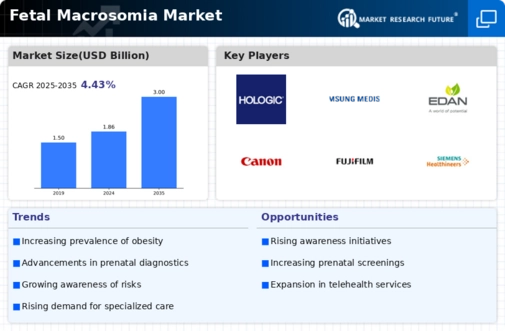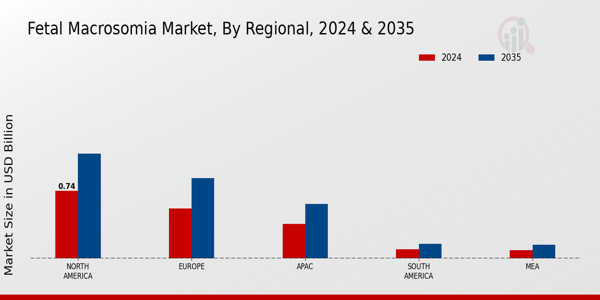Market Growth Projections
The Global Fetal Macrosomia Market Industry is projected to experience substantial growth over the coming years. With a market valuation of 1.86 USD Billion in 2024, it is anticipated to reach 3 USD Billion by 2035, reflecting a compound annual growth rate of 4.44% from 2025 to 2035. This growth is driven by various factors, including the rising prevalence of obesity and gestational diabetes, advancements in prenatal care, and increased awareness among healthcare providers and expectant parents. The market's expansion is indicative of the growing recognition of fetal macrosomia as a critical health issue, necessitating enhanced monitoring and management strategies.
Rising Prevalence of Obesity
The increasing prevalence of obesity among pregnant women is a notable driver of the Global Fetal Macrosomia Market Industry. Obesity is linked to a higher risk of delivering larger infants, which can lead to fetal macrosomia. In 2024, the market is projected to reach 1.86 USD Billion, driven by the growing number of obese women of childbearing age. As obesity rates continue to rise globally, healthcare providers are increasingly focused on monitoring fetal growth, thereby expanding the market for related diagnostic and therapeutic solutions. This trend is expected to contribute to a compound annual growth rate of 4.44% from 2025 to 2035.
Advancements in Prenatal Care
Advancements in prenatal care technologies are significantly influencing the Global Fetal Macrosomia Market Industry. Enhanced imaging techniques, such as 3D and 4D ultrasounds, allow for better assessment of fetal growth and weight estimation. These innovations enable healthcare providers to identify potential cases of macrosomia earlier, facilitating timely interventions. As awareness of fetal macrosomia increases, more expectant mothers are receiving comprehensive prenatal care, which is likely to drive market growth. The integration of these advanced technologies into routine prenatal assessments is expected to support the market's expansion, particularly as it approaches a valuation of 3 USD Billion by 2035.
Increased Awareness and Education
Increased awareness and education regarding fetal macrosomia among healthcare professionals and expectant parents is a crucial driver for the Global Fetal Macrosomia Market Industry. Educational initiatives aimed at understanding the risks associated with macrosomia, such as delivery complications and long-term health issues for the child, are becoming more prevalent. This heightened awareness encourages proactive monitoring and management of fetal growth, leading to increased demand for diagnostic tools and interventions. As the medical community emphasizes the importance of addressing macrosomia, the market is likely to see sustained growth, contributing to its projected CAGR of 4.44% from 2025 to 2035.
Technological Innovations in Monitoring
Technological innovations in fetal monitoring are playing a pivotal role in shaping the Global Fetal Macrosomia Market Industry. The development of wearable devices and mobile health applications allows for continuous monitoring of maternal and fetal health, enabling early detection of potential macrosomia cases. These innovations facilitate timely interventions and personalized care plans, which are essential for managing the risks associated with fetal macrosomia. As these technologies become more accessible and widely adopted, they are expected to drive market growth significantly. The increasing integration of technology in prenatal care is likely to contribute to the market's anticipated growth trajectory, particularly as it approaches a valuation of 3 USD Billion by 2035.
Rising Incidence of Gestational Diabetes
The rising incidence of gestational diabetes is a significant factor impacting the Global Fetal Macrosomia Market Industry. Women diagnosed with gestational diabetes are at a higher risk of delivering larger infants, which can lead to fetal macrosomia. As the prevalence of gestational diabetes continues to rise globally, healthcare systems are increasingly focused on managing this condition to mitigate its effects on fetal growth. This trend is expected to drive demand for monitoring and treatment options, thereby expanding the market. With the market projected to reach 1.86 USD Billion in 2024, the implications of gestational diabetes on fetal macrosomia are likely to be a key area of focus for healthcare providers.

















